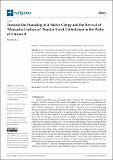Files in this item
Towards the founding of a native clergy and the revival of ‘Mamacha Cocharcas' : popular lived Catholicism in the wake of Vatican II
Item metadata
| dc.contributor.author | Lee, Christine Shen-Chirng | |
| dc.date.accessioned | 2021-02-22T12:30:02Z | |
| dc.date.available | 2021-02-22T12:30:02Z | |
| dc.date.issued | 2021-02-22 | |
| dc.identifier | 273007221 | |
| dc.identifier | 9ef90ab6-eec4-4ffe-88f9-7c36f95228f6 | |
| dc.identifier | 85102365985 | |
| dc.identifier.citation | Lee , C S-C 2021 , ' Towards the founding of a native clergy and the revival of ‘Mamacha Cocharcas' : popular lived Catholicism in the wake of Vatican II ' , Religions , vol. 12 , no. 2 , 142 . https://doi.org/10.3390/rel12020142 | en |
| dc.identifier.issn | 2077-1444 | |
| dc.identifier.uri | https://hdl.handle.net/10023/21472 | |
| dc.description | Funding: This research was funded by Santander and the University of St Andrews. | en |
| dc.description.abstract | In the years directly following the Second Vatican Council under the guidance of its second bishop Mons. Enrique Pelach i Feliu, the Andean diocese of Abancay—founded in 1959 in one of the most rural and most indigenous areas of Peru—experienced the founding of a new seminary intended to train a new generation of native clergy, and a concerted clerical effort to revive and promote the Marian pilgrimage of the Virgin of Cocharcas. The former meant the advent of a generation of native clergy made up of men born and raised in rural farming families in Abancay and native speakers of Quechua, the local indigenous language, which transformed the relationship between the institutional Church and indigenous Catholics from one rooted in antipathy and hostility to one based in a shared cultural background and language. The latter meant the elevation of the indigenous figure of Sebastian Quimichu as exemplar of both Andean Catholic faith and practice for his role in founding the Marian shrine of Cocharcas, and the legitimisation of popular Andean Catholic practices that had previously been stigmatised. This article provides a dual historical and ethnographic account of these events, and in doing so demonstrates the profound transformation of rural Andean lived religion and practice in the years following Vatican II. | |
| dc.format.extent | 13 | |
| dc.format.extent | 1978267 | |
| dc.language.iso | eng | |
| dc.relation.ispartof | Religions | en |
| dc.subject | Vatican II | en |
| dc.subject | Andes | en |
| dc.subject | Roman Catholicism | en |
| dc.subject | Cocharcas | en |
| dc.subject | BT Doctrinal Theology | en |
| dc.subject | BX Christian Denominations | en |
| dc.subject | F1201 Latin America (General) | en |
| dc.subject | E-DAS | en |
| dc.subject | NIS | en |
| dc.subject.lcc | BT | en |
| dc.subject.lcc | BX | en |
| dc.subject.lcc | F1201 | en |
| dc.title | Towards the founding of a native clergy and the revival of ‘Mamacha Cocharcas' : popular lived Catholicism in the wake of Vatican II | en |
| dc.type | Journal article | en |
| dc.contributor.institution | University of St Andrews. Social Anthropology | en |
| dc.identifier.doi | https://doi.org/10.3390/rel12020142 | |
| dc.description.status | Peer reviewed | en |
This item appears in the following Collection(s)
Items in the St Andrews Research Repository are protected by copyright, with all rights reserved, unless otherwise indicated.

